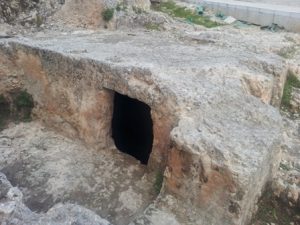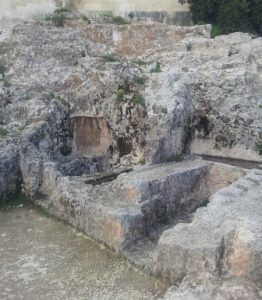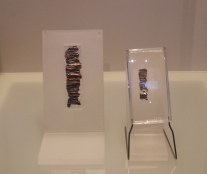The LORD bless you, and protect you;
The LORD make His face to shine upon you, and be gracious unto you;
The LORD look with favor upon you, and give you peace.
These three verses (Numbers, 6: 24-26) are in the heart of the portion named Naso and are known as the Priestly benediction. They echo throughout Jewish history from the biblical era and until this very day. You can find the Priestly benediction on various Jewish art items, in Jewish literature and you can hear them every day in synagogues while people are praying. The sight of priests getting up, wrapping themselves with the prayer shawl (Talit), spread their fingers and repeat the blessing read to them by the prayer leader is the most well known image of Jewish prayer of our time. An interesting fact is that the content of the benediction is written in the bible however there are no instructions as to how it should be performed. According to the practice of Jerusalem the priestly benediction should be performed during the Amidah (the standing prayer). The custom is derived from the Tamid tractate of the Mishna (mishna 1, chapter 5) where the daily routine of the priests in the Temple is described. The tractate says that during the dawn priests would descend to the hall of hewn stones and there they would bless the people three blessings: “Emet Veyatziv”, “Avoda” and “the priestly benediction”. Not all of the Jewish communities share this custom. Some say the priestly benediction only in Saturdays. Other save the benediction to Yom Kippur only.
Clearly the priestly benediction has been a part of Jewish life for a long time. As we already pointed out we can track it down to the second Temple period to the hall of hewn stones and to the Naso portion in its present version. This means that the blessing was already well known when the bible was canonized. The canonization process is thought to have happened during the time of Ezra and Nehemiah. In Nehemiah chapter 8 verses 1-2 it is said: “all the people gathered themselves together as one man into the broad place that was before the water gate; and they spoke unto Ezra the scribe to bring the book of the Law of Moses, which the LORD had commanded to Israel. And Ezra the priest brought the Law before the congregation, both men and women, and all that could hear with understanding…”
The event described here of reading the bible in public and signing a treaty symbolizes the canonization of texts and commandments that were written earlier in history. This is the event in which the Israelites became the people of the book.
Most of the researchers think that the event of reading the bible happened when Ezra came to Jerusalem in the seventh year of the reign of king Artachshasta the first, king of Persia – The year of 458 AD. However, he who walks through to streets of Jerusalem knows we can find an even earlier version of the priestly benediction.
During the 1980’s the known archeologist prof. Gabriel Barkay headed an excavation in an area named Ketef Hinnom. The excavations revealed some very interesting findings from the Ottoman period, a Byzantine church and many findings from the Roman period and the second Temple period. The most interesting find for us is an item dated to the end of the first Temple period. Not surprisingly the excavation showed that Ketef Hinnom was a part of Jerusalem Necropolis in the days of the first Temple. The impressing burial cave discovered here is not very different from other burial caves from this period discovered around Jerusalem (A good example for those can be found in Saint-Étienne monastery near the Nablus gate). The burial system is identical to other places and consists of a central rood surrounded by burial rooms where the bodies were laid. The body of the dead was laid on a stone bench for a year. After a year passed the bones were put in a space curved under the stone bench. As you can see the burial was not personal. The whole family was buried together. This method of burial can teach us a lot about the notion of redemption at the end of time during the first Temple period which was very different from the concept in the second Temple period when personal burial became common. These burial caves where very popular among thieves and robbers throughout history and this fact made prof. Barkay quite skeptical about finding something valuable there. However one day a young boy who took part in the excavations found a collapsed burial cave. It seemed like the cave collapsed in very early days and thus escaped the robbers. The findings were impressing: Items made of ebony, glass, clay and metal, sticks of Azure for makeup, jewelry, arrowheads. The most interesting item found were two silver plates rolled into a tubular shape that apparently served as pendants.
The researchers thought they were some kind af a scroll and sent them to the Hebrew university’s lab. It took Joseph Shenhav and David Biggleisen three years to achieve the impossible and open the tubes without damaging the content. Now they only needed to decipher the writing.
The tubes were sent to the labs in the Israel museum and using forensic techniques after a long time the researchers were able to read considerable parts of the scrolls that were dated to the end of the seventh century AD. The researchers were amazed to find to priestly benediction known to us today with only slight differences. Naturally every difference is significant and many studies were written about these.
If you want to visit the site where this amazing cave was found you are invited to visit the Begin museum in Jerusalem. After drinking a nice cup of coffee at the pleasant restaurant you can circle the building and at the back just under the Scottish St. Andrews church lies the cave that held to most ancient biblical text ever found! The Begin museum staff keeps the place clean and tidy and a sign was made to describe the findings in this place. The original scrolls are exhibited regularly in the archeological wing of the Israel museum.
Back to Home page – Tours in Jerusalem
לעמוד בעברית – סיורים בירושלים


